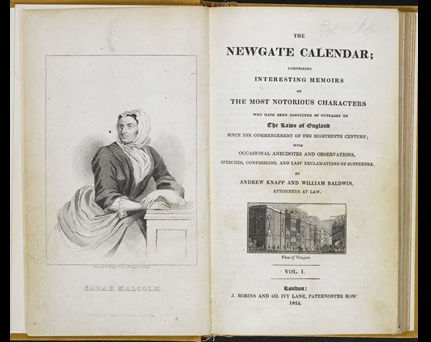Newgate novels are an early form of sensation literature, drawing their inspiration from the Newgate CalendarGenre of publications chronicling the crimes and punishments of notorious criminals., first published in 1773 as a five-volume set, and reissued in updated form in 1816 and 1826.[1] Keith Hollingsworth, an acknowledged authority on the subject,[2] has defined a Newgate novel as “one in which an important character came (or, if imaginary, might have come) out of the Newgate Calendar“.[3] The term was not one adopted by the authors, but by their critics.[1]
Crime journalism had become popular after 1718, when the publisher John Applebee persuaded the chaplains of London’s notorious Newgate prison to publish their accounts of the confessions of condemned felons, which were then often sold at Tyburn gallows on the day of execution; the Newgate Calendar consists of the biographies of such famous criminals once incarcerated in Newgate prison.[4]
Examples of the genre include Edward Bulwer-Lytton’s Paul Clifford (1830), generally considered to be the first Newgate novel,[3] William Harrison Ainsworth
English historical novelist, at one time considered a rival to Charles Dickens.‘s Rookwood (1834), and Charles Dickens’s Oliver Twist (1837).[a]Although Oliver Twist does not feature a Newgate criminal explicitly in its cast of characters, Fagin was recognisably based on the notorious fence Ikey Solomon.[5] But the most controversial of all was Ainsworth’s Jack Sheppard (1839), “condemned mainly for glamorizing an eighteenth–century housebreaker whose astounding prison escapes in the 1720s had already made him a folk hero”.[6]
Characteristics
A typical theme of the Newgate novels is their insistence that crime is a result of socio-economic disadvantage. Oliver Twist, for instance, is maltreated in the workhouse
Establishment where the destitute in England and Wales received board and lodging in return for work. as being the son of a prostitute, and on escaping falls into the hands of Fagin, drawing him into the criminal underworld.[7] Middle-class readers were encouraged to identify with the “good” criminals by the author ascribing higher-class status to their protagonists as the story unfolds; both Oliver Twist and Jack Sheppard are revealed to be high-class by birth.[8] In his second preface to Paul Clifford, written in 1848, Bulwer-Lytton explicity describes his novel as “a loud cry to society … to redeem the victim”.[9]
The protagonists of the Newgate novels are almost exclusively male, as are their authors, thus avoiding any contemporary concerns about potentially pernicious effects on respectable middle-class women.[9] Unlike later crime stories, Newgates pay little attention to its detection, being more concerned with the processes by which criminals become ensnared in their criminality.[10]
Controversy
Controversy over the Newgate novels raged most fiercely between 1830 and 1847,[5] when the middle classes were anxious about the rising crime rate, and the possibility that stories apparently glorifying criminals might tempt impressionable working-class boys into a life of crime.[11] Although it was argued by some that there was a “high moral purpose” in writing about the lives of criminals, drawing attention to “errors in penal institutions” and offering hope that “the purest good [ … ] may be drawn from the vilest evil”, many saw the Newgate novels as condoning or even advocating criminal behaviour.[5] An anonymous review published in The Church of England Quarterly in 1842 expressed the wish that the Newgate novelists, in particular, had not “pandered to a depraved appetite for excitement” because they were spreading “poison” by “palliate[ing] vice and mak[ing] crime a mere accident”.[3]
The novelist William Makepeace Thackeray was one of the genre’s most vehement critics; in a letter to his mother, dated December 1839, he wrote that at one theatrical adaptation of Ainsworth’s Jack Sheppard he had seen people in the lobby selling “Shepherd-bags”, containing “a few picklocks … a screwdriver and iron lever”, adding that “one or two young gentlemen have already confessed how much they were indebted to Jack SheppardJack Sheppard (1702–1724) was a notorious thief in early 18th-century London, wildly popular with the poorer classes. who gave them ideas of pocket-picking and thieving [which] they never would have had but for the play”.[12] Thackeray went on to write a full-length parody of the Newgate genre, Catherine: A Story,[b]Catherine: A Story tells of Catherine HayesCatherine Hayes née Hall (1690–1726), was the last woman in England to be executed by being burned alive. , who was burned alive in 1726 for conspiring to kill her husband.[13] serialised in 1839–1840 in Fraser’s Magazine.[2]
Aftermath and decline
Ainsworth’s reputation in particular suffered badly in the aftermath of the Newgate controversy. He had been considered at least the literary equal of Dickens, but according to the literary historian Steven Carver, the stigma surrounding Jack Sheppard poisoned everything he subsequently wrote. Dickens fared rather better, arguing persuasively that Oliver Twist was “a work of social realism not a jaunty criminal romance”.[11]
Newgate novels were “immensely popular” between 1830 and 1847,[1] but as they became increasingly unfashionable and controversial their form evolved and merged with the sensation novels and early detective fiction of the 1850s and 1860s. Rather than locating crime in an “exotic lower-class culture”, these later novels placed it in the “familiar space of middle-class domesticity”, and in doing so switched the emphasis from the genesis of the crime to its detection.[9]
Notes
| a | Although Oliver Twist does not feature a Newgate criminal explicitly in its cast of characters, Fagin was recognisably based on the notorious fence Ikey Solomon.[5] |
|---|---|
| b | Catherine: A Story tells of Catherine HayesCatherine Hayes née Hall (1690–1726), was the last woman in England to be executed by being burned alive. , who was burned alive in 1726 for conspiring to kill her husband.[13] |

